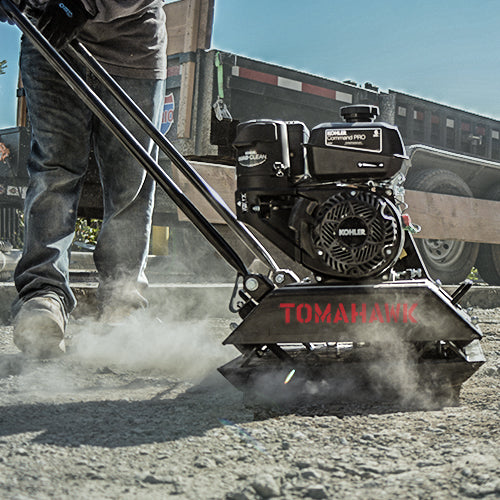Soil compaction is a very important process for any sort of construction project. The process of compaction gives the soil higher load bearing ability and greater stability by removing the air from soil particles and compressing the particles closer together. Proper compaction of soil is very important because it provides the necessary flat base which distributes the crucial support for buildings, various construction foundations, roads, pavements and any other construction structures.
Before you begin compacting soil for your project, identifying the type of soil you are compacting is vital. There are two main types of soil, granular and cohesive. Granular soil is easily identifiable because it is characterized by having gravel, sand, or silt (coarse grained soil) with little or no clay content. Dry granular soil has no cohesive strength. Granular soil cannot be molded when moist and crumbles easily when dry. The best tools for granular soil compaction are vibratory plate compactors and rollers. For large scale jobs, large ride on rollers are recommended to get the job done in a timely matter. For medium and small jobs, vibrating rollers and vibratory plate compactors are recommended due to their ease of use and ability to fit in trenches and tight spaces.
The Tomahawk Power TPC90 is a strong and durable vibratory plate compactor that is perfectly suited for compaction of landscapes, granular soil, and asphalt. Fitted with a Honda GX160 engine, the TPC90 combines power with ease of use. With its one of a kind seamed plate and curved edge, the TPC90 creates a smoother finish on the first pass than our competitors. The unique dual anti-vibratory handle system greatly increases shock absorption and reduces the vibrations felt by the user, allowing for increased comfort and stability. A polyester pad can be attached to the TPC90 in order to compact recently laid brick with speed and efficiency. Whether it is granular soil compaction, brick work, or the laying of asphalt, the Tomahawk Power TPC90 is the go to vibratory plate compactor.
Cohesive soil is the other main type of soil found at construction sites. Cohesive soil is identifiable by the presence of clay (fine grained soil), or soil with a high clay content, which has cohesive strength. Cohesive soil does not crumble and can be deformed or molded without cracking when moist. Cohesive soil is hard to break up when dry, and exhibits significant cohesion when over watered. The best equipment to use for cohesive soil compaction are tamping rammers (aka jumping jacks) and pad foot vibratory rollers as their high impact forces enable the flatter cohesive particles to compress greater than if using a vibratory plate. For larger projects, large rollers fitted to compact cohesive soils are highly recommended. For smaller projects and trench work, tamping rammers are the perfect fit.
The Tomahawk Power TR68 Tamping Rammer is ideal for cohesive soil compaction. Equipped with a 4 stroke Honda GX100 gasoline engine, the TR68 delivers high levels of impact force with minimal effort. With an impressive 3400 lbs of force per square foot, the TR68 can compact cohesive soil up to 26 inches. The 13 x 11 in shoe size is perfect for both trench work and regular compaction jobs. The Tomahawk Power TR68 is leading the compaction industry in comfort, speed, and power.
When working with either granular or cohesive soil, it is important to apply a level of moisture to the project to allow for the water to fill in the voids of the granular soils and produce a better foundation. The amount of water present in a soil mass affects the ease of compaction operations and the achievable soil density. Each soil has its particular optimum moisture content (OMC) at which a corresponding maximum density can be obtained for a given amount of compaction force.
The easiest and simplest way to properly measure moisture levels are with a simple "hand test". This test will give you basic information about soil moisture content without any special tools. By molding the soil in your hand and dropping it you can verify whether or not it has the right moisture content. If the soil is too powdery and cannot hold the shape of your hand, it is too dry. If the soil only breaks into a couple pieces when dropped, the proper level of moisture is achieved. If the soil sticks to your hand and holds the shape of your hand when dropped, too much moisture is present.
Hot, dry, sunny, or windy weather often found in Southern California is conducive to drying the soil by evaporating the moisture. In a desert climate, evaporation claims a large amount of water intended for the soil lift. Thus, for a dryer environment, project managers may have to apply greater amounts of moisture than usually required. This allows the actual moisture content as close to the desired level as possible when compacting and stabilizing soil.











